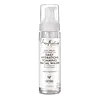What's inside
What's inside
 Key Ingredients
Key Ingredients

 Benefits
Benefits

 Concerns
Concerns

 Ingredients Side-by-side
Ingredients Side-by-side

Water
Skin ConditioningDecyl Glucoside
CleansingCocamidopropyl Betaine
CleansingGlycerin
HumectantDicaprylyl Ether
EmollientPanthenol
Skin ConditioningSodium PCA
HumectantAllantoin
Skin ConditioningButyrospermum Parkii Butter
Skin ConditioningCocos Nucifera Oil
MaskingAcacia Senegal Gum Extract
Nelumbo Nucifera Extract
Skin ConditioningTocopherol
AntioxidantGlyceryl Oleate
EmollientTapioca Starch
Maltodextrin
AbsorbentGuar Hydroxypropyltrimonium Chloride
Skin ConditioningParfum
MaskingTriethyl Citrate
MaskingCaprylyl Glycol
EmollientBenzoic Acid
MaskingWater, Decyl Glucoside, Cocamidopropyl Betaine, Glycerin, Dicaprylyl Ether, Panthenol, Sodium PCA, Allantoin, Butyrospermum Parkii Butter, Cocos Nucifera Oil, Acacia Senegal Gum Extract, Nelumbo Nucifera Extract, Tocopherol, Glyceryl Oleate, Tapioca Starch, Maltodextrin, Guar Hydroxypropyltrimonium Chloride, Parfum, Triethyl Citrate, Caprylyl Glycol, Benzoic Acid
Water
Skin ConditioningGlycerin
HumectantDecyl Glucoside
CleansingCocamidopropyl Betaine
CleansingLeuconostoc/Radish Root Ferment Filtrate
AntimicrobialNiacinamide
SmoothingMelaleuca Alternifolia Leaf
AbrasiveAllantoin
Skin ConditioningAlgae
Skin ConditioningCamellia Sinensis Callus
AntimicrobialCera Alba
EmollientPanax Ginseng Root Extract
EmollientZingiber Officinale Water
MaskingAloe Barbadensis Leaf Extract
EmollientVitis Vinifera
MaskingSymphytum Officinale Leaf Extract
Skin ConditioningChamomilla Recutita Meristem Cell Culture
Skin ConditioningSymphytum Officinale Callus Culture Lysate
Skin ConditioningCucumis Sativus Oil
EmollientVaccinium Myrtillus Fruit Extract
Skin ConditioningSaccharum Officinarum Extract
MoisturisingAcer Saccharum Sap
HumectantCitrus Aurantium Dulcis Peel Cera
EmollientCitrus Medica Limonum Peel
Skin ConditioningCitric Acid
BufferingWater, Glycerin, Decyl Glucoside, Cocamidopropyl Betaine, Leuconostoc/Radish Root Ferment Filtrate, Niacinamide, Melaleuca Alternifolia Leaf, Allantoin, Algae, Camellia Sinensis Callus, Cera Alba, Panax Ginseng Root Extract, Zingiber Officinale Water, Aloe Barbadensis Leaf Extract, Vitis Vinifera, Symphytum Officinale Leaf Extract, Chamomilla Recutita Meristem Cell Culture, Symphytum Officinale Callus Culture Lysate, Cucumis Sativus Oil, Vaccinium Myrtillus Fruit Extract, Saccharum Officinarum Extract, Acer Saccharum Sap, Citrus Aurantium Dulcis Peel Cera, Citrus Medica Limonum Peel, Citric Acid
Ingredients Explained
These ingredients are found in both products.
Ingredients higher up in an ingredient list are typically present in a larger amount.
Allantoin is a soothing ingredient known for its protective and moisturizingg properties. Because of this, it is often added to products with strong active ingredients.
Studies show higher concentrations of this ingredient can promote wound healing.
Though it can be derived from the comfrey plant, allantoin is produced synthetically for cosmetic products to ensure purity.
Learn more about AllantoinCocamidopropyl Betaine is a fatty acid created by mixing similar compounds in coconut oil and dimethylaminopropylamine, a compound with two amino groups.
This ingredient is a surfactant and cleanser. It helps gather the dirt, pollutants, and other impurities in your skin to be washed away. It also helps thicken a product and make the texture more creamy.
Being created from coconut oil means Cocamidopropyl Betaine is hydrating for the skin.
While Cocamidopropyl Betaine was believed to be an allergen, a study from 2012 disproved this. It found two compounds in unpure Cocamidopropyl Betaine to be the irritants: aminoamide and 3-dimethylaminopropylamine. High-grade and pure Cocamidopropyl Betaine did not induce allergic reactions during this study.
Learn more about Cocamidopropyl BetaineDecyl Glucoside is a glucose-based surfactant and emulsion stabilizer. It is created by reacting glucose with the fatty acids from plants.
Surfactants help clean the skin by trapping oil, sebum, and dirt to be washed away. As an emulsion stabilizer, it stabilizes the ingredients in a product by preventing them from separating.
This ingredient is biodegradable and non-toxic. This ingredient is commonly found in baby shampoos.
Decyl Glucoside is sometimes used to stabilize the UV filter Tinosorb.
Learn more about Decyl GlucosideGlycerin is already naturally found in your skin. It helps moisturize and protect your skin.
A study from 2016 found glycerin to be more effective as a humectant than AHAs and hyaluronic acid.
As a humectant, it helps the skin stay hydrated by pulling moisture to your skin. The low molecular weight of glycerin allows it to pull moisture into the deeper layers of your skin.
Hydrated skin improves your skin barrier; Your skin barrier helps protect against irritants and bacteria.
Glycerin has also been found to have antimicrobial and antiviral properties. Due to these properties, glycerin is often used in wound and burn treatments.
In cosmetics, glycerin is usually derived from plants such as soybean or palm. However, it can also be sourced from animals, such as tallow or animal fat.
This ingredient is organic, colorless, odorless, and non-toxic.
Glycerin is the name for this ingredient in American English. British English uses Glycerol/Glycerine.
Learn more about GlycerinWater. It's the most common cosmetic ingredient of all. You'll usually see it at the top of ingredient lists, meaning that it makes up the largest part of the product.
So why is it so popular? Water most often acts as a solvent - this means that it helps dissolve other ingredients into the formulation.
You'll also recognize water as that liquid we all need to stay alive. If you see this, drink a glass of water. Stay hydrated!
Learn more about Water